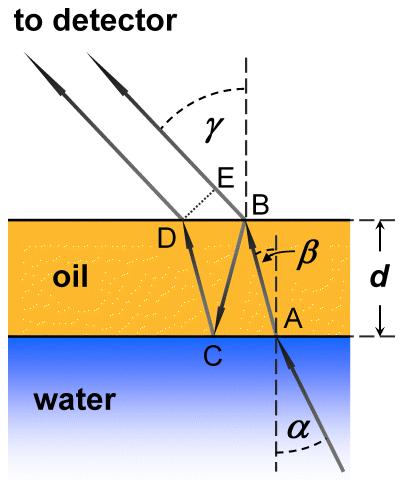Airborne Oil Pollution Patrol 4:
Interference Fringes of Oil on Water: Supplement
Equations
Scenario
|
We want to get a deeper understanding of the interference fringes
observed with microwave radiometry. In the graph, the geometric difference
of the path of rays Δs of the waves is:
|
Exercises
This is what students can do (continued from Worksheet Marine Pollution C02-03):
- Using trigonometric relations and Snell’s Law, show that the geometric path difference Δs of the waves holds as given above, depending on the oil layer thickness d, the refractive index n of the oil, and the incidence angle α.
- Please calculate the phase difference of waves for an oil layer thickness from 0 to 5 mm in steps of 0.25 mm with the following data: f=34 GHz, noil=1.41, γ=50°. Take also into account the phase jump of the wave reflected at point C. Verify the correctness of the position of maxima and minima of the brightness temperature curve shown on page 2 of the supplement on Microwave Radiometers.
Solution to exercises
- Distances , , and are identical. Therefore: The following relations hold: With one obtains:
Materials
- Student version of this supplement worksheet: Interference fringes of oil on water, as html page or as printable rtf file
- Oil pollution and the fate of oil at sea
- Airborne maritime oil spill surveillance
- The Microwave Radiometer
Time needed
- Two school lessons and two exercises for homework
Procedure
- These exercises can be used as homework in physics, following a discussion of Worksheet Marine Pollution C02-02-3 in the class room.
Background Information
- Textbooks on optics; the topic is identical with the interference of light waves that are transmitted through (or: reflected by) a thin plane parallel glass plate.

